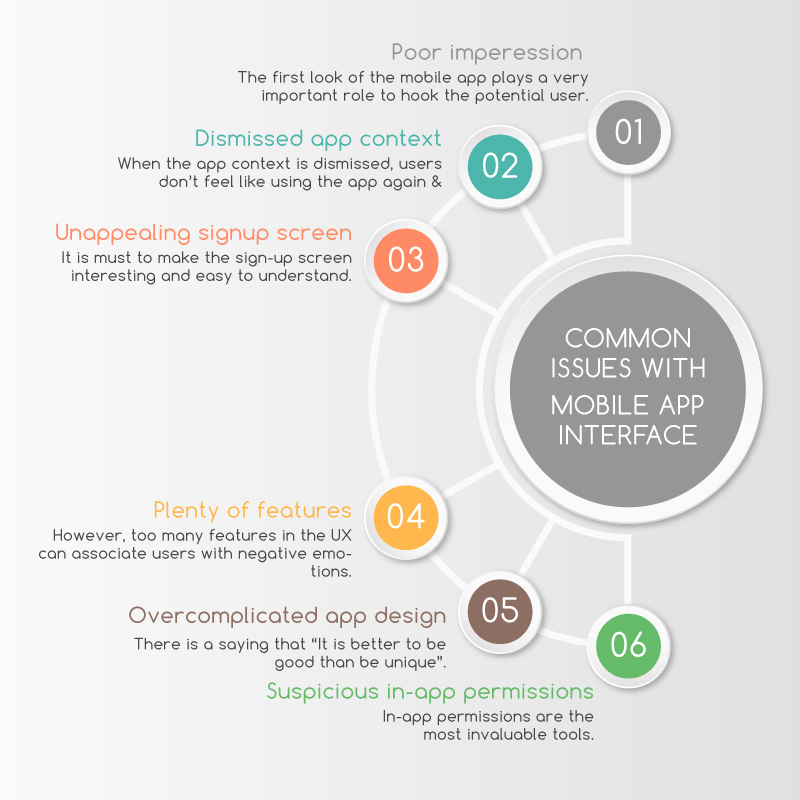What are the common issues with mobile app interface design?
Mobile app development is huge and is growing constantly, no matter how you measure it. The advent of cloud computing and advanced devices has begun to transform every aspect of our life. The year 2017 is going to be a big year for smartphones, as they are going to overtake computers and laptops. In order to keep pace with the rapidly changing world, mobile app developers are developing new and creative mobile apps. As there are many differences between mobile and desktop computing devices, designing mobile apps is quite different than desktops and laptops.
If any part of mobile app is not appealing, users are likely to install new one. The common issues come with mobile app interface design. Most of the apps live and die in first few days. If you want the mobile app to hit the Play Store with a bang and sustain for years, go through the below issues with mobile app interface design and avoid them in your app.
Poor impression
This is one of the most common issue with mobile app interface design. The first look of the mobile app plays a very important role to hook the potential user. The users are disinterested, if anything appears boring or confusing. When the users come to your app, they see it for the first time. It is must to develop app that is intuitive and introduces the most exciting features quickly. We advise you to go through the beta testing processes to learn how to hook the users from the beginning. App developers should analyze the use of their apps with a feedback loop to check what is working and what isn’t.
Dismissed app context
Mobile devices are very good at connecting users and the consumption of information is likely the largest segment of mobile device usage. Users have very specific needs and they want them to be accomplished in an easy way. Because of this fact, mobile interfaces should be designed with – feature sets that are optimized to streamline common use case and progressively displayed, large buttons for interactions and so on. When the app context is dismissed, users don’t feel like using the app again and again, and eventually switch to other app. Mobile app developers should create the app considering the immediate situation in which the app is intended to be used.
Unappealing signup screen
Sign up screen of the mobile app is one of the first things, which your user is going to experience with your brand. Mobile app developer often takes it for granted and welcome the users with a bad design. The signup screen should help the user know what it does for him/her and convince that they need it. If you make the prospective users feel that they have to work to sign-up, then they will abandon your app. It is must to make the sign-up screen interesting and easy to understand.
Suspicious in-app permissions
In-app permissions are the most invaluable tools. However, they raise the suspicion of today’s mobile app users, due to which many people will not grant access to their personal information and social media profiles. To access this type of information, mobile app developers should explain the users why they are asking for privileged information. This will not only encourage users to trust your company, but will eliminate questionable in-app permissions from the product. Your mobile app is more likely to enjoy a good rate of user retention.
Plenty of features
Mobile app developers often believe that – more the number of features, more the user retention. No doubt, users love having access to plenty of features, which makes sense from logical perspective. However, too many features in the UX can associate users with negative emotions. Users don’t respond well having too many features in the UX. Instead of adding too many features, mobile app developers should focus on improving the existing features that users enjoy. Avoid adding unnecessary features that bloat up the UI, as it is the place where you are likely to get more ROI.
Over complicated app design
There is a saying that “It is better to be good than be unique”. Make sure that the design of user interface is meeting the user requirements before you add more features. When the mobile app developer adds multiple things to make the composition look more exciting and appealing, they get diverted from the main objective. Mobile app developers may use symbols and icons in excess to provide visual clues in an easy way. This may confuse the user and diminish his interest in your app. It is better to give the elements on the screen some room to breathe. There is a great need for white space that has transcended digital world, and hence it should not be underrated.
In order to build an app with appealing user interface, it is must to focus on user requirements. Avoid the above mentioned issues while designing mobile app interface. Most of these issues can be fixed easily without spending much. Whenever you are designing a mobile app, make sure to pay more attention to the user interface and user experience. Your design team must have a coherent vision of what your mobile app is going to achieve. Consider what type of users is going to use your mobile app. Refine the features and design until nothing can take way your app from failing.
Still have your concerns?
Your concerns are legit, and we know how to deal with them. Hook us up for a discussion, no strings attached, and we will show how we can add value to your operations!
